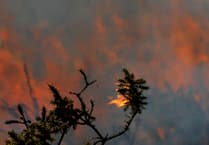DAMON Albarn, formerly of pop groups Blur and Gorillaz, has added celebrity muscle to the campaign to protect the future of Hallsands.
Albarn, who has owned a house near the village for more than 15 years, credits the inspiration for the multimillion-selling Gorillaz album Plastic Beach to a walk on Hallsands.
He told Radio 4’s Today Programme in 2010: ‘I was walking on Hallsands beach in south Devon around 18 months ago, where I have a house just on the cliffs above it. It’s a very clean beach generally, but I realised that there was an amount of very small particles that weren’t stone or glass, but plastic. It was the beginning of a meditation on the state of our oceans.’
Lending his support to the ‘No Second Betrayal’ campaign, Albarn recently wrote a poetic defence of the village and the beach: ‘I fell in love with Hallsands nearly 20 years ago. From the moment I laid eyes on it I knew it was a magical place.
‘Cradled by Start Bay, illuminated – on clear nights – by the stars, but always by the lighthouse, it can vanish in sea fog one moment and reappear bathed in sunshine the next.
‘But this is a story of erosion, from the ghostly remains of the old village still clinging to the cliffs to the sad demise of the hotel, home of the world’s best cider and apple cake, to the seasonal ravaging of the shingle by an inveterate sea.
‘It is a peaceful place, where 20 people on the beach is considered the busiest day of the year, where the water can be so clear it is comparable to the Aegean, when the sun shines and the horizon is so vast you can want for nothing more in life than this precious place. But it is disappearing and at an alarming rate.
‘In fact, it disappeared almost completely in 1917, when a violent storm destroyed all houses bar one, leaving 128 people homeless on the cliffs above, and this is the story now.
‘With each storm the sea’s trident rakes the shingle far out into the bay, leaving a blackened primordial shelf. The shingle of Hallsands is always in flux. Sometimes it seems every stone tells an ancient story. I always find heart-shaped stones and sometimes geodes. When it’s quiet, cormorants and seals come within touching distance from the shore and behind a city of reeds hides a teeming wildlife.
‘In short, as the descendants of the original villagers live out their quiet lives, the forces of nature are gradually destroying this magical place. We need the Government to listen to the people of Hallsands – and countless other remote communities like them – otherwise we will lose a living link with our past.’
The N2B campaign aims to have the shoreline management status changed from the current ‘no active intervention’ judgement, which leaves Hallsands to the mercy of future coastal erosion.
The group’s name refers to the disaster of 1917, when the old village of Hallsands collapsed into the sea during a storm. In 2002 local journalist and author Steve Melia revealed in his book, Hallsands,
A Village Betrayed, how fishermen and their families were cheated out of compensation recommended by an independent inspector.
David Marcer from the N2B campaign said: ‘Damon brilliantly captures the essence of Hallsands and describes its vulnerability to the changing moods of the sea.
‘We were lucky last winter – the sea defences didn’t move much and only a small amount of the road was washed away. The summer visitors who parked there probably didn’t even notice the damage. Neither would they have realised that, unless our sea defences are maintained properly, one big winter storm is all it will take for the road to be lost, and only a couple more before there’s serious damage to property.
‘But our campaign is about more than saving a strip of road and a few houses. It’s about saving something that’s precious to the many, many people who come here at all times of the year, but especially in the summer. People who love the unspoilt, special qualities of Hallsands that Damon describes.
‘He’s right – the Government needs to listen to us. The Government must change our classification under the shoreline management plan so that we’re on a par with our neighbouring villages of Beesands and Torcross. If our designation remains as ‘no active intervention’, then it’s inevitable that sooner or later there’ll be no more road, no more free parking, no more boats on trailers, no more kayakers, no more fishermen and no more families in cars.’
After several years of campaigning, it was confirmed last December that no public money would be spent on protecting the village in the future.
Sarah Wollaston MP, who initially championed the campaign, tweeted: ‘The majority would not support diverting scarce resources for coastal erosion away from prioritising Slapton Line.’



Comments
This article has no comments yet. Be the first to leave a comment.